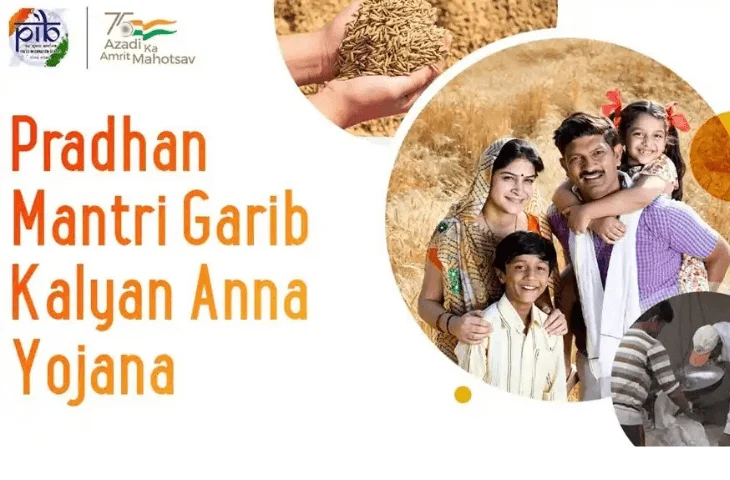The Pradhan Mantri Garib Kalyan Anna Yojana (PMGKAY) is a flagship welfare initiative by the Government of India aimed at ensuring food security for the nation’s poorest citizens. The scheme was launched in March 2020 during the COVID-19 pandemic, PMGKAY was designed to provide immediate relief to economically vulnerable sections of society.
Under this scheme, beneficiaries receive 5 kg of free food grains per person per month, in addition to the subsidized ration under the National Food Security Act (NFSA). The program ensures that households under financial stress or crises like the pandemic have access to essential food supplies, preventing hunger and malnutrition.
Why was PMGKAY Introduced?
The primary motivation for PMGKAY was to address food scarcity during economic and social crises. India, being home to a large population living below the poverty line, faced unprecedented challenges during the pandemic.
Lockdowns disrupted income sources, especially for daily wage workers, migrant laborers, and rural households. By providing free food grains, the government sought to:
- Ensure food security for vulnerable populations.
- Alleviate economic hardships during crises.
- Prevent the spread of malnutrition and health-related issues.
- Support the broader Atmanirbhar Bharat initiative, promoting self-reliance and welfare.
Who are the Beneficiaries of PMGKAY?
The scheme primarily targets the economically weaker sections of society, especially those covered under NFSA and the Antyodaya Anna Yojana (AAY).
Eligible groups include:
- Families identified under Antyodaya Anna Yojana (AAY) and Priority Households (PHH).
- Households headed by widows, elderly (60+), terminally ill, or disabled persons with no assured means of subsistence.
- Primitive tribal households and marginalized communities.
- Landless agricultural laborers, marginal farmers, rural artisans, and craftsmen like potters, weavers, blacksmiths, carpenters.
- Informal sector workers, including porters, rickshaw pullers, handcart pushers, fruit and flower sellers, ragpickers, and slum dwellers.
- Families of HIV-positive individuals under the BPL category.
State governments and Union Territories identify PHH based on criteria set by the Central Government, ensuring that the most deserving households are included.
Check Out: Complete List of Important Schemes for NABARD Grade A Exam
What are the Key Features of PMGKAY?
PMGKAY has multiple dimensions to support vulnerable groups beyond just food distribution. Some key features include:
- Free food grains: 5 kg of rice or wheat per person per month, plus 1 kg of free chana per family.
- Subsidized ration: Additional food grains provided under the Public Distribution System (PDS) at nominal rates.
- Fuel support: Free LPG cylinders for BPL households to improve access to cooking fuel.
- Financial relief: In 2020, the scheme included cash transfers and other financial assistance for daily wage earners and migrant laborers.
- Health and insurance benefits: Frontline workers received insurance coverage of up to ₹50 lakh to protect them during the pandemic.
- Employment support: Through integration with schemes like MGNREGA, PMGKAY indirectly promoted rural employment and income generation.
How yhas PMGKAY Evolved Over Time?
PMGKAY has undergone multiple phases since its inception in 2020. Each phase was designed to meet the changing requirements during the pandemic and post-pandemic periods:
| Phase | Duration | Key Objective |
| Phase I | April – June 2020 | Initiated emergency food support during the initial lockdown |
| Phase II | July – November 2020 | Continued support to mitigate prolonged economic hardship |
| Phase III | May – June 2021 | Addressed food shortages during the second COVID-19 wave |
| Phase IV | July – November 2021 | Sustained food assistance and ration distribution |
| Phase V | December 2021 – March 2022 | Continued sustained food assistance and ration distribution |
| Phase VI | April – September 2022 | Estimated additional subsidy of ₹80,000 crore for food grains |
Get ready to crack government job exams with leading educators
How is PMGKAY Administered?
The scheme is managed by the Department of Food and Public Distribution under the Ministry of Consumer Affairs, Food, and Public Distribution. Implementation occurs through:
- Public Distribution System (PDS): Ensures distribution of free and subsidized grains to eligible households.
- State and UT Governments: Identify beneficiaries and ensure last-mile delivery.
- One Nation One Ration Card (ONORC) Scheme: Allows beneficiaries to access ration entitlements from any part of the country.
What are the Objectives of PMGKAY?
While PMGKAY emerged as a pandemic-specific relief measure, its objectives align with broader social welfare goals:
- Food Security: Guarantee access to essential food grains for the poor.
- Economic Relief: Provide direct support to daily wage earners, migrant laborers, and low-income households.
- Social Protection: Extend insurance and financial assistance to frontline workers and vulnerable families.
- Rural Development: Promote rural employment indirectly through allied schemes like MGNREGA.
- Crisis Management: Build a robust framework for supporting citizens during unforeseen economic or social crises.
Also Check: List of Government Schemes of India
What are the Benefits of PMGKAY?
PMGKAY offers numerous advantages for both individuals and society:
- Financial Inclusion: Provides direct support to the poor.
- Food Security: Ensures free food grains to prevent hunger.
- Social Security: Offers insurance and fuel support.
- Rural Economy Boost: Supports income through employment programs.
- Health and Nutrition: Improves nutrition with grains, chana, and LPG.
- Women Empowerment: Helps women participate in economic activities.
- Crisis Resilience: Provides quick relief during emergencies.
What Challenges does PMGKAY Face?
Despite its success, PMGKAY encounters certain obstacles:
- Implementation Gaps: Delays and bureaucratic hurdles affect delivery.
- Incomplete Coverage: Some deserving households are left out.
- Fund Allocation Issues: Mismanagement limits full program reach.
- Awareness Deficit: Beneficiaries may not know their entitlements.
- Corruption and Leakages: Resources sometimes don’t reach the intended people.
- Digital Infrastructure Dependence: Poor connectivity affects monitoring and distribution.
- Short-Term Relief Focus: Focuses on immediate relief, not long-term poverty solutions.
What is the Relationship between PMGKAY and Other Welfare Schemes?
PMGKAY is part of the broader Atmanirbhar Bharat Abhiyan, which encompasses:
- One Nation One Ration Card (ONORC): Ensures portability of PDS entitlements.
- MGNREGA: Provides employment support, complementing income and food security.
- Ayushman Bharat Scheme: Health coverage for economically weaker sections.
- Pradhan Mantri Kisan Samman Nidhi (PM-KISAN): Financial support to farmers.
Key Takeaways
| Aspect | Details |
| Full Name | Pradhan Mantri Garib Kalyan Anna Yojana (PMGKAY) |
| Launch Date | March 2020 (COVID-19 Relief), original PMGKY in 2016 |
| Ministry | Ministry of Consumer Affairs, Food & Public Distribution |
| Objective | Food security, financial and social support for vulnerable populations |
| Beneficiaries | BPL, AAY, PHH families, elderly, disabled, tribal, daily wage workers |
| Provision | 5 kg free food grains per person/month + 1 kg chana/family/month |
| Administration | PDS system, state governments, ONORC for portability |
| Phases | I-VI (2020-2022) with planned extensions |
| Key Benefits | Food security, financial relief, health insurance, rural economy boost |
| Challenges | Implementation gaps, leakages, awareness deficit, short-term focus |
Questions on PMGKAY
- Who launched the Pradhan Mantri Garib Kalyan Anna Yojana?
a) PM Narendra Modi
b) CM Nitish Kumar
c) Finance Minister
d) Union Minister
e) None of the above - When was PMGKAY introduced as a COVID-19 relief measure?
a) March 2020
b) April 2019
c) January 2020
d) December 2016
e) June 2020 - What is the primary provision of PMGKAY?
a) Free LPG cylinders
b) Cash transfer to poor families
c) 5 kg free food grains per person per month
d) Pension scheme
e) Health insurance - Which Ministry is responsible for PMGKAY?
a) Ministry of Finance
b) Ministry of Consumer Affairs, Food & Public Distribution
c) Ministry of Health
d) Ministry of Rural Development
e) Ministry of Social Justice - Which of the following is a key eligibility criterion for PMGKAY?
a) All citizens of India
b) Families under Antyodaya Anna Yojana (AAY)
c) Only urban poor
d) Employees in private companies
e) Students - Which scheme ensures portability of PMGKAY entitlements across India?
a) PM-KISAN
b) ONORC (One Nation One Ration Card)
c) Ayushman Bharat
d) MGNREGA
e) PM-JDY - How much free chana is provided under PMGKAY per family per month?
a) 0.5 kg
b) 1 kg
c) 2 kg
d) 5 kg
e) None - Which segment of workers benefits indirectly from PMGKAY through MGNREGA?
a) IT workers
b) Rural laborers
c) Bank employees
d) Teachers
e) Police personnel - What are the challenges associated with PMGKAY?
a) Implementation delays
b) Leakages and corruption
c) Awareness deficit
d) Short-term relief focus
e) All of the above - Which phase of PMGKAY was operational during April–September 2022?
a) Phase III
b) Phase IV
c) Phase V
d) Phase VI
e) Phase II
Also Read:
Answer Key:
| Question No. | Answer |
| 1 | a) PM Narendra Modi |
| 2 | a) March 2020 |
| 3 | c) 5 kg free food grains per person per month |
| 4 | b) Ministry of Consumer Affairs, Food & Public Distribution |
| 5 | b) Families under Antyodaya Anna Yojana (AAY) |
| 6 | b) ONORC (One Nation One Ration Card) |
| 7 | b) 1 k |
| 8 | b) Rural laborers |
| 9 | e) All of the above |
| 10 | d) Phase VI |
- Government Schemes for NABARD Grade A 2025
- MISHTI Scheme, India’s Initiative to Restore Mangrove Ecosystems
- National Green Hydrogen Mission Features, Objectives, and Benefits
- Paramparagat Krishi Vikas Yojana, Transforming India’s Organic Farming
- Mission on Integrated Development of Horticulture NHM and HMNEH
- Swachh Bharat Mission, India’s Journey Towards Cleanliness and Hygiene

Priti Palit, is an accomplished edtech writer with 4+ years of experience in Regulatory Exams and other multiple government exams. With a passion for education and a keen eye for detail, she has contributed significantly to the field of online learning. Priti’s expertise and dedication continue to empower aspiring individuals in their pursuit of success in government examinations.
